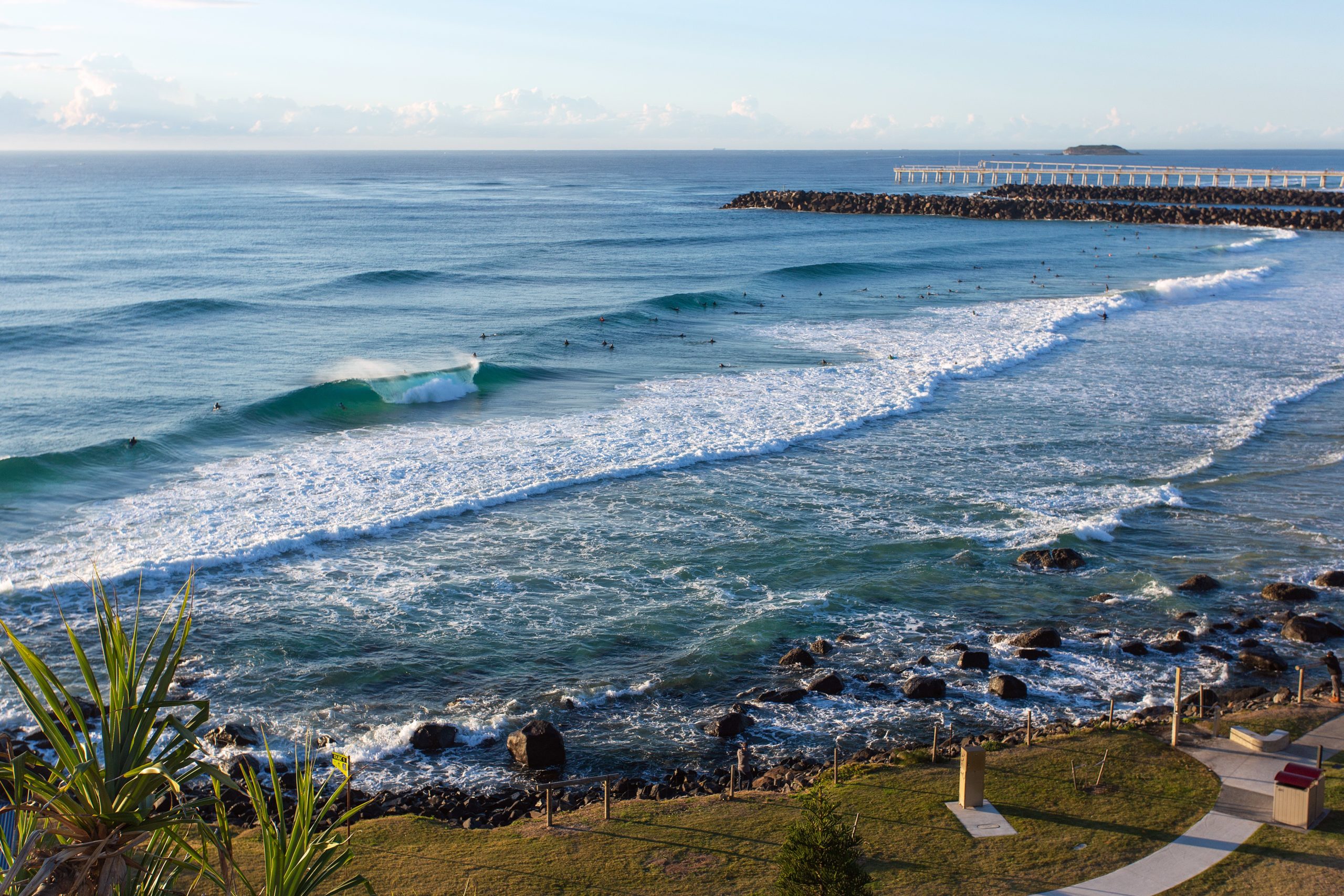MOY NGAGAMBI
Moy Ngagambi (black dingo) beach has always been there at the mouth of the Tweed but has been held to an artificial shape by rock walls since the late 1800s. The spirit of the black dingo lives here: he’s a law keeper, and he travels up and down the coast.
The traditional owners of the area are the Gudjinburra-Minyangbal. They’re Bundjalung peoples – other Bundjalung groups include the Arakwal people of the Byron Bay area. Bundjalung country extends along the coast of what is now the NSW-Queensland border region, from the Tallebudgera Creek to the Clarence; and further back, Bundjalung land extended from the Logan to the Clarence. Today it’s a field of Australian aspiration – high rises and coffee culture, SUVs and malls. Moy Ngagambi, like the beach of any city, is a place of transition where nature still moves in unregulated shapes. Fifty metres out it’s the uncontained energy of the Pacific Ocean. But fifty metres back from the drifting sand, it’s the electronic birdcall of pedestrian crossings.
The language spoken here is Nganduwal, and there’s a name in that tongue for the faint outline of rock on the horizon: Jungurra Ngarian, known these days as Cook Island. Jungurra Ngarian is the centre of an aquatic reserve, a kilometre in diameter and extending almost all the way back to the headland of Booninybah, or Fingal Head. You can still snorkel and dive out there (you just can’t fish) and you’re likely to see giant Queensland groper, black rock cod, estuary cod and grey nurse sharks.
Local people have always gathered seafood here: fish, crabs, oysters and other shellfish, alongside bird species and animals from kangaroos down to lizards and a variety of plants. Everything that isn’t poisonous or sacred would be hunted in the right season for that particular species, taking care to avoid certain animals in their breeding seasons.
Moy Ngagambi and its surrounds have produced their share of famous Australians: right now it’s the rapper and dancer Jacob ‘JK-47’ Paulson, but in years past there’s been Churaki, said to be the first recorded lifesaver, who assisted many people on the Southern Gold Coast, and Neville Bonner, who was born on an island in the Tweed River and went on to become the first Aborigine in our federal Senate. Author Melissa Lucashenko is a Bundjalung woman: she won a Walkley for non-fiction in 2013, and the prestigious Miles Franklin Award last year for her novel Too Much Lip.
Captain James Cook went past Moy Ngagambi around 1770, throwing names like confetti – Mt Warning, Point Danger – but John Oxley was the first white person to come up the river, in 1823. By the time he came back down, four hundred warriors had gathered to watch him. Escaped convicts from Moreton Bay and then the cedar-getters followed, and there were conflicts in the early days, some resulting in massacres of local clans around the Tweed. Land at Booninybah and other places in the valley was handed back under the Land Rights Act before Native Title existed. The Tweed Byron Land Council has managed these lands on behalf of Community for generations now.
Traditional activities have continued around Moy Ngagambi. Despite ups and downs over decades, some Gudjinburra have avoided forcible removal from traditional lands, enabling many cultural practices like hunting, fishing and gathering to go on. Also alive and well are the social structures and ceremonies that are vital to cultural life. The community has its issues, ones that are comparable to other Indigenous communities, but here, land management challenges are intensified as the Bundjalung live pretty much on the doorstep of one of Australia’s fastest growing cities. Land is central to cultural systems for Aboriginal people: preserving culture requires preserving the land, and the pressure from outside is intense sometimes. The message is not nobody come near us, but regulation and respect are essential to maintain the land and culture into the future.
The Gudjinburra are well-represented by a range of organisations and elders groups. You can learn more by talking to the Tweed-Byron Aboriginal Land Council, the Tweed Elders Group or the Tweed Aboriginal Co-Op. – Kyle Slabb with Jock Strong
Surfing World acknowledges the Traditional Owners of Country throughout Australia and recognise their continuing connection to land, waters and culture. We pay our respects to their Elders past, present and emerging.








